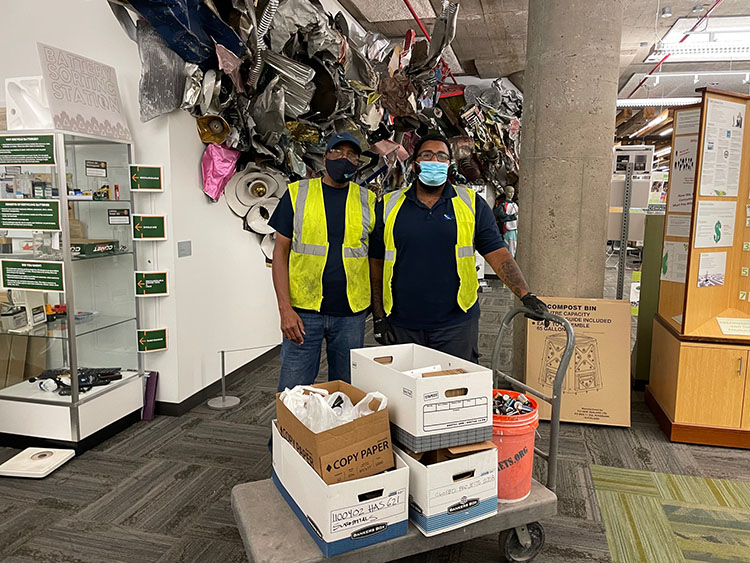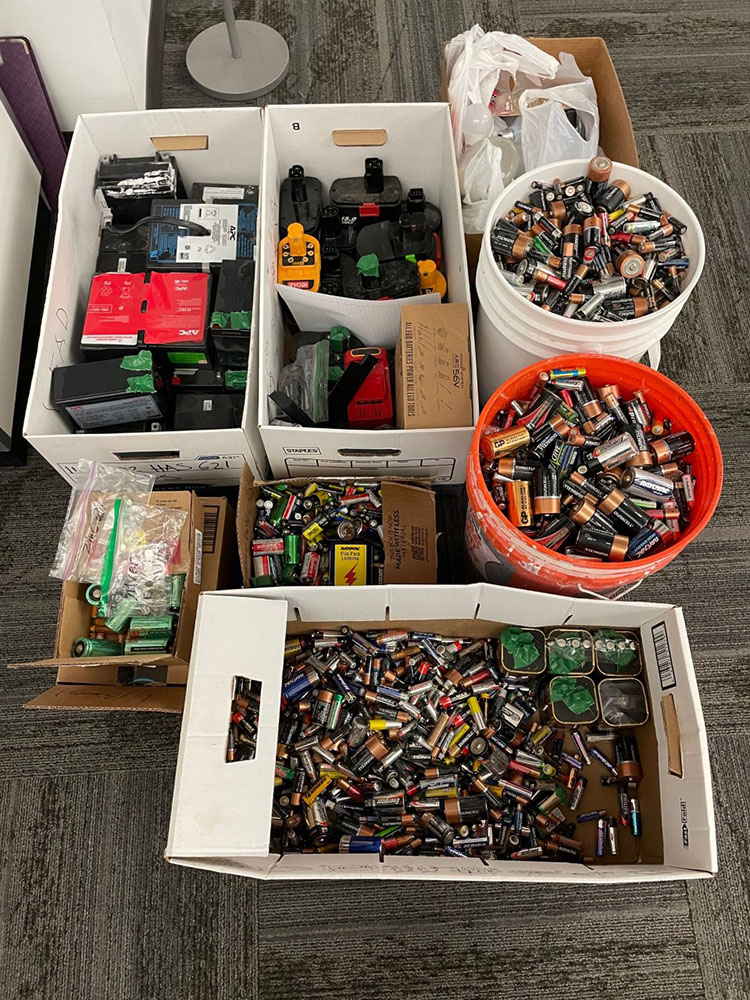What is zero waste? An impossibility for the living human. The short definition: it is the diversion of 90% of waste. That’s as good as it gets unless you are a fanatic. Zero is a goal, otherwise it’s 10% waste.
You might think, ‘oh please, surely you jest’. Fine, try it. Google it and you’ll see the major success stories with their mason jar of trash for the year. Oops, not zero. And these people are fanatics. In a good way.

Indicative of the system is an illustration of the players in the residential consumer circle of life. It’s only a system in theory, as the different players don’t really care about the other players.
Keep in mind that Manufacturers have wasted so much material by the time the product gets sold that we could almost stop the discussion at this point. The current estimate by EPA, which is potentially flawed, is that post-consumer waste is only 3% of industrial waste produced by manufacturers and industry. Still, it is highly likely that industrial waste greatly exceeds post-consumer waste by a gigantic margin.
Anyway, back to the system – manufacturers REALLY LIKE being ‘done’ with their product after you buy it from them or through the marketing/retail world. If you break it or wear it out, you own it and you aren’t giving it back to them. If their product even hints at being recyclable, they want to assuage consumer guilt to retain market share and will try to convince you people who care about waste that their product is recyclable.
The plastics industry has done a spectacular job of convincing Americans that all plastic is recyclable. My absolute favorite quote on this is from Brian Dougherty’s 2008 book Green Graphic Design –
SYMBOLS OF CONFUSION
In a master stroke of deceptive communications, the Society of the Plastics Industry in 1988 appropriated the chasing arrow triangle, a universal symbol for recycling, as part of their system for labeling types of plastic resins. Consumers have been confused ever since. The symbol used on plastics suggests recycled content and real-world recyclability, yet it means something different. The symbol simply indicates which family of plastic resins a product or component is made of. The suggestion of recycled content is completely false. After two decades of miscommunication, plastics are by far the most likely material to be labeled with a “recycled” symbol, yet they are among the least likely materials to actually be recycled.
Meanwhile, around 40% of the post-consumer waste stream is packaging. Clearly, we need some packaging to protect products during transport because broken products don’t sell or work well. Some packaging is quite recyclable, such as paper and cardboard. Interestingly, paper and cardboard can also be composted back to natural materials, not that they are or should be. Styrofoam (which is a brand name) and correctly labeled polystyrene foam for packaging is technically recyclable but extremely rarely recycled. It is 95% air and ingenious, but no one wants it. Sadly, it often contaminates recyclable cardboard and shows up in the single-stream recycling bins. Then - we have the “Frankenstein” packaging products that are combinations of paper and plastic or foil, or whatever, and they are totally non-recyclable.
Municipalities are often mandated to dispose of trash. Texas mandates this of its jurisdictions. Few states mandate recycling, like California. Houston offers single stream recycling, and unfortunately must take care of the excessive contamination of non-recyclables that comes with it. It seems to be a daunting task to “educate” people to “recycle right”. Municipalities can juggle trucking trash to the landfill, trucking recyclables to the MRF (Materials Recycling Facility), trucking yard waste to the mulch contractor, or trucking food waste to the compost facility. Houston is doing three of them now, hopefully on a path to promoting food waste composting (nature’s way of recycling). And municipalities must juggle between their consumer citizens and the processors who can only do what they have contracted to do, and it’s not a glorious business, is it?
Haulers want to haul and get paid. That’s it. Don’t ask them to weed through the waste unless you want to pay them extra for it. Speaking of a not-glorious business. Any aspiring waste haulers out there?
Processors are robotizing their operations as fast as they can. Houston was mentioned in Adam Minter’s 2013 book Junkyard Planet when he interviewed Alan Bachrach (coincidentally one of my first speakers in 2009 at a Green Building Resource Center educational seminar) about Waste Management’s very sophisticated MRF at the time, as well as Alan’s rich history in the recycling business. And here’s the rub – more is better. The more recyclables they process, the more money they make. The more contamination, the more they charge back to the hauler/municipality. If REDUCE were to really take hold, that wouldn’t be so great for business for the MRF processors.
Finally, we have bales of recycled material ready for industry to take and reuse to make recycled products. This actually happens with paper and cardboard! Did you know you can purchase 100% post-consumer content paper? Yes, you can actually increase demand for paper recycling by not purchasing virgin wood-based paper (which has a long, long list of environmental problems associated with it, not the least of which is all the bleach used to make it whiter). If we don’t have a market for recycled materials from the MRF’s, well, let’s think about it. What do the MRF’s DO with the material they can’t sell or give away? That’s not a pretty picture, because it costs serious money to sort all that material – more in Houston than landfilling it. Meanwhile, contamination in single stream recycling is sorted out at this great expense and then trucked to the landfill at landfill expense, which is, as mentioned, charged back to the municipality.
Let’s imagine now what zero-waste looks like. First, we have a hall pass to landfill 10% of our hard to recycle waste. Oh, and in the 10% is the household-hazardous-waste that we aren’t allowed to landfill, which needs to be taken – by you – to an environmental service center for a much more regulated disposal. And that is not recycling, by the way. That leaves 90% of your waste to be reused, recycled, or composted. And of course, you can just hold onto stuff in case some day we are able to recycle it (not a great option – think ‘hoarding’).
Food waste is a big slice of the waste stream pie chart (12 to 25%). If you compost you know this. If you can’t compost, then you know we need a separate food waste collection method. Some jurisdictions pick it up from your curb (adding transportation). Subscription pick up services are popping up (google Zero Waste Houston). New York City offers drop off locations (my personal favorite after composting your own at home). That way you divert your food waste at your schedule to your local drop off location. Keep in mind, food waste can be contaminated with non-food items, like condiment packets and the pesky stickers on fruit and vegetables (why are they not bio-degradable yet?).
Clothing, electronics, metal items, furniture, and a host of items that we don’t want after a certain point need to be disposed of and they are not recyclable at curbside. You, dear reader to be zero-waste, must proactively search for a taker of these items. Adam Minter wrote a subsequent and fascinating book called Secondhand: Travels in the New Global Garage Sale, in case you want to know what happens to your donated items.
Then we have curbside recycling. It’s mostly packaging. To get a good feel with where we are with that, read Terracycle’s Tom Szaky’s The Future of Packaging: From Linear to Circular for background intel from the product manufacturers. They are trying to improve, but at a pace recyclers like me don’t resonate with. And a huge problem with voluntary recycling programs is contamination. People are not clear on what is recyclable and what isn’t, which is a sad situation. Recyclability of materials is not self-evident, and it is local, causing inconsistencies and confusion even among folks with the best of intention. A particularly unhappy trend is called ‘wish-cycling’ which identifies the mentality that ‘if I’m not sure it’s recyclable, it ought to be and I want it to be, so I will give it the benefit of the doubt and throw it in with the recycling’. This unfortunately is a flawed thought process. To be correct, the mantra should be ‘when in doubt, throw it out’.
Happily, a zero-waster is a person who wants to excel at their disposal practice. They tend to be inquisitive and learn about what is and what isn’t recyclable. This helps them with their purchasing criteria, and they buy less of the items that are not recyclable. More importantly, they tend to buy less items because they can predict the future of those items and don’t want to face disposing of them. They tend to converse about disposability in general with friends and perhaps are pushing the manufacturing industry to “begin with the end in mind” as we learned from Stephen Covey’s The Seven Habits of Highly Successful People.
Interestingly there is a green rating system regarding zero waste called TRUE, an acronym for Total Resource Use and Efficiency. It’s quite involved and is used by organizations to reduce and effectively divert their waste down to below 10%. Keep in mind that this saves these entities serious money. It would be the subject of another blog post, but I mention it to let you know of yet another tendency of industry to recognize that waste is a sign of inefficiency that costs them and that they can actually manage it to their benefit after some self-examination and training.
It is very important for industry to catch on here that ‘designing for the dump,’ as Annie Leonard so eloquently put in “The Story of Stuff” in 2007 (19 minutes on YouTube), is a practice that needs to end. She addressed the disjointed, dysfunctional system discussed in this blog, as well as pointing out the massive amount of waste generated in a product before the consumers even buy it. The manufacturers and marketers do what’s best for them, as do the consumers, municipalities, haulers, and MRF’s. We don’t have any integration to speak of. Blaming others is rampant as is snail’s pace progress.
And this blog does not have any magic answers! People really want answers! Well, this is a problem with a label called a “wicked problem” I first heard about in George Marshall’s Don’t Even Think About It: Why Our Brains Are Wired to Ignore Climate Change. We have six parties in this problem, and until we have a coherent game plan, we won’t progress much.
Here is what EPA shows us:
NOW, THEREFORE BE IT RESOLVED, that The United States Conference of Mayors adopts a definition of Zero Waste, and set of Zero Waste principles, that recognizes a Hierarchy of Material Management as follows:
- Extended Producer Responsibility and Product Redesign
- Reduce Waste, Toxicity, Consumption, and Packaging
- Repair, Reuse and Donate
- Recycle
- Compost
- Down Cycle and Beneficial Reuse
- Waste-Based Energy as disposal
- Landfill Waste as disposal

Illustration by Energy Justice Network – www.energyjustice.net/zerowaste
I do see some improvement over the past decade, especially the US Conference of Mayors getting involved, but clearly, we need more effort from everyone’s part. Feel free to google Extended Producer Responsibility (EPR). The short version of EPR is Maine’s attempt to mandate cigarette manufacturers to contribute to a fund for municipalities to use to educate the public about cigarette butt litter and to fund cleaning up initiatives and processes to both divert and clean them from the landscape. Of course cigarette manufacturers will raise their prices, and the cost will be borne by the smokers. Is that fair? Think about how long non-smokers have subsidized all problems caused by smoking.
Recycling is regulated better in other countries, and of course, worse in others. We could use better regulation as a good first step. Maybe a better first step is to communicate with the manufacturers to up their game. We could vote with our wallet and not buy egregious products that waste too much (gee, that’s easy to say – what products waste too much?). The bottom line is: “If you see something, say something”. Get active, criticize bad actors, tell them what you would like to see. The plastics industry is paying attention right now. When this meme hit Facebook, things started to bubble up: “In 2050 there will be more plastic than fish in the oceans”. As usual, Einstein’s definition of insanity keeps staring us in the face: “Insanity is doing the same thing over and over and expecting different results”. Let’s make something different happen. Zero wasters already are.








